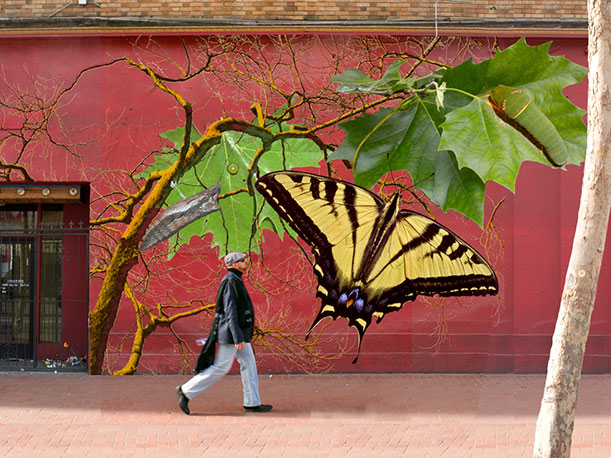corridors of nature...in the city

A Butterfly Species Settles in San Francisco’s Market Street
Two advocates track Western tiger swallowtails through the city and use art to encourage residents to think of the fluttering creatures as welcome neighbors
By Aleta George for smithsonian.com
August 28, 2013
“Nature is everywhere,” says lepidopterist Liam O’Brien about the tigers of San Francisco’s Market Street—Western tiger swallowtail butterflies, that is.
O’Brien and naturalist Amber Hasselbring of Art-ecology have launched a campaign called “Tigers on Market Street” to speak for the butterflies that live in the canopy of trees that line the busiest street in downtown San Francisco. They are bringing the butterfly’s story to light using science and art as the City of San Francisco re-imagines the role of this hardworking boulevard in a project called Better Market Street. On blank walls and in Powerpoint talks given to groups throughout the city, the duo display photographs, paintings and fantastical collages of the butterflies and the urban world in which they live.
One of the options being considered for Better Market Street is to make way for a Copenhagen-style bike path by removing many of the London plane trees planted 40 years ago. O’Brien and Hasselbring are all for the bike paths, but their mantra is “bikes and butterflies.”
“This is not an ugly brown butterfly,” says O’Brien. “We’re talking the biggest, showiest, prettiest butterfly we have in the city.”
If you stand at the Ferry Building and look up Market Street you can see why the butterflies view the boulevard as a river canyon, their normal habitat. Naturalist John Muir also referred to city streets as canyons—he said he was more comfortable picking through an ice field than to be in the “terrible canyons of New York.” But to a butterfly, San Francisco’s city canyons provide a kind of haven.
Some species of butterflies need hillside habitats, but a tiger swallowtail lives in corridors on the banks of waterways. “Market Street is a tree-lined linear concourse that our species calls a street,” says O’Brien. “Through the point-of-view of the creature this is a river.”
To understand how a street becomes a river to these creatures, you have to slip into that point of view, says O’Brien. It’s not the species of tree that attracts them as much as it is the topographical lay. They patrol long linear things with plantings on both sides. “It’s a random accident that this street looks just like a river,” he says, “which is the magic of this story.”
They are also attracted to glades, which, in San Francisco, means open areas downtown that are protected by an initiative approved by voters in 1984 that controls shadows from tall buildings. The glades and nearby parks provide sunlight, water from fountains or sprinklers, nectar sources and an increased chance of finding a mate.
continue reading here

